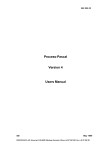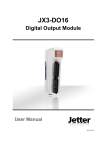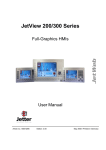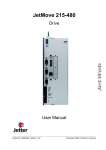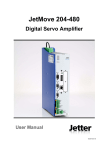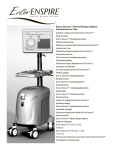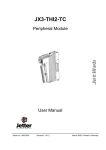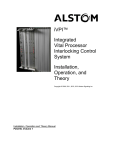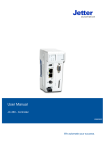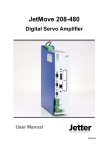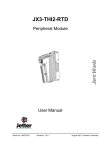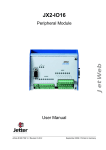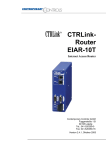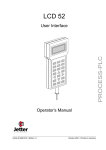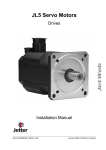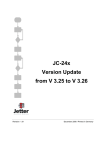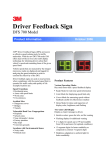Download User manual
Transcript
JX3-BN-CAN JetWeb Peripheral Module User Manual Article no.: 608 721 35 Edition: 1.03.2 October 2007 / Printed in Germany Introduction JetWeb Edition 1.03.2 Jetter AG reserves the right to make alterations to its products in the interest of technical progress. These alterations need not be documented in every single case. This User Manual and the information contained herein have been compiled with due diligence. However, Jetter AG assume no liability for printing or other errors or damages arising from such errors. The brand names and product names used in this document are trademarks or registered trademarks of the respective title owner. 2 Jetter AG JX3-BN-CAN Introduction How to Contact us: Jetter AG Gräterstraße 2 D-71642 Ludwigsburg Germany Phone - Switchboard: Phone - Sales: Phone - Technical Hotline: +49 7141 2550-0 +49 7141 2550-433 +49 7141 2550-444 Fax - Sales: E-mail - Sales: E-mail - Technical Hotline: +49 7141 2550-484 [email protected] [email protected] This User Manual belongs to the JX3-BN-CAN: Type: Serial #: Year of construction: Order #: To be entered by the customer: Inventory #: Place of operation: © Copyright 2007 by Jetter AG. All rights reserved. Jetter AG 3 Introduction JetWeb Significance of this User Manual This User Manual is part of the JX3-BN-CAN and • • and must be kept in a way that it is always at hand until the JX3-BN-CAN will be disposed the JX3-BN-CAN must be handed over, if it is sold, alienated, or loaned Please contact the manufacturer in any case you encounter difficulties to clearly understand this User Manual. We would appreciate any suggestions and contributions on your part and would ask you to contact us. This will help us to produce manuals that are more user-friendly and to address your wishes and requirements. This User Manual contains important information on how to transport, erect, install, operate, maintain and repair the JX3-BN-CAN. Therefore, the persons carrying out these jobs must carefully read, understand and observe this User Manual, and especially the safety instructions. Missing or inadequate knowledge of the User Manual results in the loss of any claim of liability on part of Jetter AG. Therefore, the operating company is recommended to have the instruction of the persons concerned confirmed in writing. History 4 Edition Comment 1.03.1 Original issue 1.03.2 Changes, see Recent Revisions (on page 38) Jetter AG JX3-BN-CAN Introduction Description of Symbols This sign is to indicate a possible impending danger of serious physical damage or death. Warning This sign is to indicate a possible impending danger of light physical damage. This sign is also to warn you of material damage. Caution This sign indicates hazard of life due to electric shock caused by a high operating voltage. Warning This sign is to indicate hazard of serious physical damage or death due to accidentally touching dangerous parts of the device. Warning You are asked to wear goggles. Failure to comply may lead to bodily injuries. Warning This sign is to warn you of material damage due to applying hard blows or shocks to the motor flange and shaft. This sign is to indicate a possible impending situation which might bring damage to the product or to its surroundings. It also identifies requirements necessary to ensure faultless operation. Important Jetter AG 5 Introduction JetWeb You will be informed of various possible applications and will receive further useful suggestions. It also gives you words of advice on how to efficiently use hardware and software in order to avoid unnecessary efforts. Note ·/- Enumerations are marked by full stops, strokes or scores. Operating instructions are marked by this arrow. Automatically running processes or results to be achieved are marked by this arrow. PC and user interface keys. Reference to a program or file. This symbol informs you of additional references (data sheets, literature, etc.) associated with the given subject, product, etc. It also helps you to find your way around this manual. 6 Jetter AG JX3-BN-CAN Contents Contents 1 Safety Instructions 1.1 1.2 1.3 2 3 5 6 22 Register Array for JX3 Modules .........................................................................................22 Indirect Access to JX3 Module Registers ..........................................................................25 Diagnostics and Administration 6.1 6.2 6.3 6.4 6.5 18 Technical Data ...................................................................................................................18 Description of Connections ................................................................................................18 Module Numbering.............................................................................................................20 Register Addressing 5.1 5.2 16 Technical Data ...................................................................................................................16 Description of Connections ................................................................................................16 Meaning of LEDs ...............................................................................................................17 Module Register for the Logic Voltage of the JX3 Modules...............................................17 Jetter System Bus Connections 4.1 4.2 4.3 13 Product Description JX3-BN-CAN .....................................................................................13 Minimum Requirements .....................................................................................................14 Scope of Delivery...............................................................................................................14 Document Survey ..............................................................................................................15 Power Supply 3.1 3.2 3.3 3.4 4 Generally Valid Safety Instructions ......................................................................................9 1.1.1 Usage to the Intended Purpose .............................................................................9 1.1.2 Non-Intended Use..................................................................................................9 1.1.3 Who may Operate the Device? ...........................................................................10 1.1.4 Modifications and Alterations to the Module........................................................10 1.1.5 Repair and Maintenance......................................................................................10 1.1.6 Decommissioning and Disposal ..........................................................................10 Ensure Your Own Safety ...................................................................................................11 1.2.1 Malfunctions.........................................................................................................11 1.2.2 Information Signs and Labels ..............................................................................11 Instructions on EMI ............................................................................................................11 Introduction 2.1 2.2 2.3 2.4 9 28 Diagnostics by LEDs..........................................................................................................28 Diagnostics by JX3 Module Registers ...............................................................................29 Connection Monitoring at the Jetter System Bus...............................................................32 Connection Monitoring by the JX3 System Bus.................................................................34 Electronic Data Sheet (EDS) .............................................................................................34 7 Recent Revisions 38 8 Survey of Module Registers 39 Jetter AG 7 Contents 9 Design 9.1 9.2 10 JetWeb Physical Dimensions..........................................................................................................40 Connections .......................................................................................................................41 Operating Conditions 10.1 10.2 10.3 10.4 40 42 Environment and Mechanics..............................................................................................42 Enclosure ...........................................................................................................................43 Direct Current Input Connectors and Output Connectors..................................................44 Shielded Data and I/O Lines ..............................................................................................45 11 Glossary General 46 12 Glossary Peripherial Modules 50 13 List of Illustrations 52 14 Index 53 8 Jetter AG JX3-BN-CAN 1 Safety Instructions 1 Safety Instructions 1.1 Generally Valid Safety Instructions The device complies with the valid safety regulations and standards. Special emphasis was given to the safety of the users. Further, the user should adhere to the following regulations: • • • 1.1.1 relevant accident prevention regulations; accepted safety rules; EC guidelines and other country-specific regulations. Usage to the Intended Purpose Usage to the intended purpose includes operation in accordance with the User Manual. The JX3-BN-CAN module is for remote connection of JX3 expansion modules to all controllers of the JetControl series. Up to 8 expansion modules can directly be connected to the JX3-BN-CAN bus head. By means of a JX3-PS1 module, eight further JX3 modules can be connected. The supply voltage of the JX3-BN-CAN module is DC 24 V. This operating voltage is classified as SELV (Safety Extra Low Voltage). The JX3-BN-CAN module is therefore not subject to the EU Low Voltage Directive. The JX3-BN-CAN module may only be operated within the limits of the stated data. The device is used to control machinery, such as conveyors, production machines, and handling machines. 1.1.2 Non-Intended Use The device must not be used in technical systems which to a high degree have to be failsafe, e.g. ropeways and aeroplanes. If the device is to be run under ambient conditions which differ from the conditions mentioned in chapter Operating Conditions (on page 42), the manufacturer is to be contacted beforehand. Jetter AG 9 1.1 Generally Valid Safety Instructions 1.1.3 JetWeb Who may Operate the Device? Only instructed, trained and authorised persons are permitted to operate this device. Transport: Installation: Commissioning: 1.1.4 Only by personnel with knowledge in handling electrostatically sensitive components. Only by specialists with training in electrical engineering. Only by specialists with extensive knowledge of, and experience with, electrical engineering / drive technology. Modifications and Alterations to the Module For safety reasons, no modifications and changes to the device and its functions are permitted. Any modifications to the device not expressly authorised by the manufacturer will result in a loss of any liability claims to Jetter AG. The original parts are specifically designed for the device. Parts and equipment of other manufacturers are not tested on our part, and are, therefore, not released by us. The installation of such parts may impair the safety and the proper functioning of the device. Any liability on the part of Jetter AG for any damages resulting from the use of non original parts and equipment is excluded. 1.1.5 Repair and Maintenance This device must not be repaired by the operators themselves. The device does not contain any parts that could be repaired by the operator. The device must be sent to Jetter AG for repair. 1.1.6 Decommissioning and Disposal The environmental regulations for the respective country apply to decommissioning and disposing of devices on the operating company’s premises. 10 Jetter AG JX3-BN-CAN 1.2 1 Safety Instructions Ensure Your Own Safety Isolate the JX3-BN-CAN module from the mains, if maintenance works have to be carried out. By doing so, you will prevent accidents resulting from electric voltage and moving parts. Warning Safety and protective devices, e.g. the barrier and cover of the terminal box must never be shunted or by-passed. Dismantled protective equipment, such as the fuses must be reattached prior to commissioning and checked for proper functioning. Prior to commissioning, the machine manufacturer shall conduct a hazard analysis for the machine and take appropriate measures to prevent personal injury and damage to property resulting from accidental movements. 1.2.1 Malfunctions In case of failures or damages, disconnect the device from the mains immediately. Malfunctions or other damages are to be reported to an authorised person at once. The device must be protected from improper or inadvertent use. 1.2.2 Information Signs and Labels Writings, information signs, and labels always have to be observed and kept readable. Damaged or unreadable information signs and labels have to be exchanged. 1.3 Instructions on EMI The noise immunity of a system corresponds to the weakest component of the system. For this reason, correct wiring and shielding of cables is of paramount importance. Jetter AG 11 1.3 Instructions on EMI JetWeb Important! Measures for increasing immunity to interfering in electric plants: The JX3-BN-CAN module has to be attached to a DIN rail acc. to EN 50022-35 x 7.5. Follow the instructions given in Application Note 016 "EMC-Compatible Installation of the Electric Cabinet" published by Jetter AG. The following instructions are excerpts from Application Note 016: On principle, physical separation should be maintained between signal and power lines. We recommend spacings greater than 20 cm. Cables and lines should cross each other at an angle of 90°. Shielded cables must be used for the following lines: Analog lines, data lines, motor cables coming from inverter drives (servo output stage, frequency converter), lines between components and interference suppressor filter, if the suppressor filter has not been placed at the component directly. Shield cables at both ends. Unshielded wire ends of shielded cables should be as short as possible. The entire shield has, in its entire perimeter, be drawn behind the isolation, and then be clamped under an earthed strain relief with the greatest possible surface area. 12 Jetter AG JX3-BN-CAN 2 Introduction 2 Introduction 2.1 Product Description JX3-BN-CAN Via the module JX3-BN-CAN, the JX3 expansion modules can be connected to all controllers of the JetControl series as remote manuals. Up to 8 expansion modules can directly be connected to the JX3-BN-CAN bus head. By means of a JX3-PS1 module, eight further JX3 modules can be connected. Product Description JX3-BN-CAN Article # 10000544 Module code 30 LED-display Connection X18 Supply voltage Communication of the JX3 system bus Connection to the Controller BUS-IN Jetter system bus Connection X19 BUS-OUT Jetter system bus Connection X10 Power supply for logic circuit Connection X119 8 modules can be connected directly, 8 further modules via a JX3-PS1 module Baud rate, address, bus termination: automatically Configuration of the Jetter system bus Jetter AG 13 2.2 Minimum Requirements 2.2 JetWeb Minimum Requirements The functions described in this document have got minimum requirements on modules, controllers and software. They have been listed in the following table. System Requirements Controller / Software 2.3 Starting from Software Release JC-24x V 3.23 JX6-SB / JX6-SB-I V 2.18 JC-647 V 3.50 JetSym V 3.00 JM-D203-JC-24x V 1.12 Scope of Delivery Scope of Delivery JX3-BN-CAN Article # 14 Quantity Description 10000544 1 JX3-BN-CAN 60870409 1 60870411 10 60871026 1 BU_02_BLZF_SW_RM3.5 2-pin female connector, contact spacing 3.5 mm DIV_DEK_5/5_MC-10_NEUT._WS Terminal markers Installation Instructions Jetter AG JX3-BN-CAN 2.4 2 Introduction Document Survey Document Survey of the JX3-I/O System JX3-I/O System, User Information JX3-BN-CAN, Installation Manual Document Survey of the JX2-I/O System JX2-I/O System, User Information SysBus_Configuration_xxx_e.xls Configuration aid for the Jetter system bus: The file can be processed in Microsoft Excel directly. xxx: Version index Jetter AG 15 3.1 Technical Data JetWeb 3 Power Supply 3.1 Technical Data Power supply has to be made through a 24 V DC power supply unit with SELV output. The power supply must meet the following requirements: Power Supply Unit Requirements Rated voltage DC 24 V Voltage range -15 % ... +20 % Filtering of the residual ripple <5% Power consumption 0.5 A x 24.0 V = 12 W max. The JX3-BN-CAN module generates several internal supply voltages out of the connected voltage supply. If all internal supply voltages are ok, the R-LED is lit green. 3.2 Description of Connections Assignment of Terminal X10 View Pin X10.DC24 V X10.0V 16 Signal + 24 V 0V Comment Supply voltage Reference potential Jetter AG JX3-BN-CAN 3.3 3 Power Supply Meaning of LEDs Module JX3-BN-CAN has been equipped with four LEDs. The LEDs R and E indicate the status of the voltage supply. LEDs View LED Color Status Function R green Off At least one internal power supply is not ok All internal voltage supplies are ok No error is lit E 3.4 red Off Module Register for the Logic Voltage of the JX3 Modules The JX3-BN-CAN module internally generates three different kinds of voltages. The voltage of the logic supply of the JX3 modules can be read via module register 10. Voltage of the JX3 Module Logic Supply Module Reg. Description Access Value Range Value After Reset Jetter AG 10 The JX3-BN-CAN module supplies the connected JX3 modules with a 5 V logic voltage. Read only 0 ... 5,500 [Millivolt] 5,000, typical 17 4.1 Technical Data JetWeb 4 Jetter System Bus Connections 4.1 Technical Data The JX3-BN-CAN module can be integrated into the Jetter system bus directly via the connections BUS-IN X18 and BUS-OUT X19. Technical Data 4.2 Setting the module number automatically Setting the baud rate automatically Bus terminating resistor automatically Description of Connections Assignment of Terminal X18 View 18 Pin Signal 1 CMODE0 2 CL 3 GND 4 CMODE1 5 TERM 6 unassigned 7 CH 8 unassigned 9 do not connect Comment internally shunted by X18.3 Jetter AG JX3-BN-CAN 4 Jetter System Bus Connections Assignment of Terminal X19 View Pin Signal 1 CMODE0 2 CL 3 GND 4 CMODE1 5 TERM 6 unassigned 7 CH 8 unassigned 9 do not connect Comment Important! For deactivating the internal bus terminating resistor, pin X19.5 must be connected with pin X19.3 at JX3-BN-CAN. In original Jetter AG connection cables for the Jetter system bus, pin 3 has been shunted by pin 5 in the connector. Jetter AG 19 4.3 Module Numbering 4.3 JetWeb Module Numbering At numbering the modules at the Jetter system bus, the I/O module number and the slave module number are differentiated. The module number is part of the coding for input and output numbers, as well as for the register numbers of the expansion modules, which are connected to the Jetter system bus. I/O Module Number An I/O module number is not assigned to all non-intelligent JX2 modules and all JX3 modules. I/O module numbers are assigned according to the following rules: • • • • • I/O module number 1 is always assigned to the controller. I/O module number 2 is assigned to the first non-intelligent JX2, respectively JX3 module connected to the Jetter system bus. The modules JX2-PS1 and JX3-PS1 are not counted. Intelligent JX2 modules are not counted. The first JX3-BN-CAN connected to the Jetter system bus is assigned to I/O module number 33. Slave Module Number A slave module number is assigned to all intelligent JX2 modules and JetMove motion systems. Slave module numbers are assigned according to the following rules: • • • The controller is always assigned to slave module number 1. The first intelligent JX2 module connected to the Jetter system bus is assigned to slave module number 2. Non-intelligent JX2 and JX3 modules are not counted. Example: Module Numbering In this example, various expansion modules have been connected with a JC-24x. The I/O module numbers are shown above, the slave module numbers below the modules. 20 Jetter AG JX3-BN-CAN 4 Jetter System Bus Connections Figure 1: Module numbering in the Jetter system bus Survey of the Module Numbers Jetter AG Module I/O Module Number Slave Module Number JC-24x JX2-ID8 JX2-ID8 JX2-SM2 JX3-BN-CAN JX3-DIO16 JX3-DI16 JX2-PS1 JX2-ID8 JX2-ID8 JX2-SM2 JX3-BN-CAN JX3-DIO16 JX3-DI16 JX3-DI16 1 2 3 33 4 5 6 7 34 8 9 10 1 2 3 - 21 5.1 Register Array for JX3 Modules JetWeb 5 Register Addressing 5.1 Register Array for JX3 Modules Each JX3 module is equipped with over 10,000 module registers. The module registers, on the other hand, have been assigned to the controller registers. By means of registers, process, configuration and diagnose data can be read by module JX3-BN-CAN, respectively written to the module. Registers can be accessed directly in the application program of the controller, in a setup window of JetSym, or via the user interface directly. Register number 3 0 0 z Module register number The meaning depends on the module Register prefix The meaning depends on the controller The register number results from a register prefix and a module register number. The register prefix depends on the position of the JX3-BN-CAN module in the Jetter system bus, and on the controller that is applied. At determining the register prefixes, the following parameters have to be considered: • • • 22 Controller (JC-24x, JC-64x, JC-800, JM-D203-JC-24x) Submodule position (at JX6-SB, JX6-SB-I) I/O module number in the Jetter system bus Jetter AG JX3-BN-CAN 5 Register Addressing JX3-I/O-modules connected to JC-24x and JM-D203-JC-24x 3 x x z Module register number: 0...9 I/O module number in the Jetter system bus - 2: 0...61 JX3-I/O module array: 3 JX3-I/O modules connected to JX6-SB(-I) and JC-647 3 m 0 3 x x z Module register number: 0...9 I/O module number in the Jetter system bus - 2: 0...61 I/O module range: 03 Submodule position: 1...3 Array: 3 JX3-I/O modules connected to JX6-SB(-I) and JC-800 4 C M 0 3 x x z Module register number: 0...9 I/O module number in the Jetter system bus - 2: 0...61 I/O module range: 03 System bus module: 1...2 Module board number: 1...3 Array: 4 Jetter AG 23 5.1 Register Array for JX3 Modules JetWeb Example: Register and I/O Addressing of a JX3 Module in the Jetter System Bus Six modules, JX3-BN-CAN (33, 34), JX3-DI16 (2, 4) and JX3-DIO16 (3, 5), have been connected to a JC-24x controller. The register and I/O numbers listed in the table below result from the module position in the Jetter system bus. • • • In the Jetter system bus, no I/O numbers have been assigned to the JX3-BN-CAN. The first JX3-BN-CAN connected to the JetControl is assigned the I/O module number 33. The first JX3 module is assigned I/O module number 2. Register and I/O Numbers 24 I/O Module Number Module Register Number I/O Numbers 1 JC-24X 101 ... 116 33 JX3-BN-CAN 0 ... 1999 20000 ... 49999 3310 ... 3319 02 JX3-DI16 3000 ... 3009 201 ... 216 03 JX3-DIO16 3010 ... 3019 301 ... 316 34 JX3-BN-CAN 3320 ... 3329 04 JX3-DI16 3020 ... 3029 401 ... 416 05 JX3-DIO16 3030 ... 3039 501 ... 516 - Jetter AG JX3-BN-CAN 5.2 5 Register Addressing Indirect Access to JX3 Module Registers Each JX3 module is equipped with over 10,000 module registers. One index and one data register make access to all 10,000 module registers possible. Figure 2: Indirect register access to JX3 modules Above, indirect access to the JX3 module registers (2) has been illustrated. In the Jetter system bus, the JX3 modules can be accessed via register numbers 3xxz (1). At indirect access, the number of the JX3 module register is written to 3xx7. After this, the content of the JX3 module register can be accessed via 3xx8. Register Numbering Dependent on the Controller • • • For JC-24x controllers: Register number 3xxz For JC-647 controllers: Register number 3m03xxz For JC-800 controllers: Register number 4CM03xxz Indirect Register Access in the Application Program • Jetter AG Indirect access to JX3 module registers of a module may only be carried out within a task. If indirect access is made out of several tasks, the index may be overwritten after a task change. 25 5.2 Indirect Access to JX3 Module Registers JetWeb Index for Indirect Register Access Module Register Description Access Value Range Value After Reset Comment 7 At indirect register access to JX3 modules, the index contains the module register number. It functions as a pointer. read and write access 0 ... 9999 9 After switching on, the index points to the module register "operating system version". Data for Indirect Register Access Module Registers Description Access Value Range Value After Reset 8 This module register is for reading, respectively writing, the value of the selected module register. The JX3-BN-CAN module copies the value of the actual module register to this register. Read and write access 32 bits Operating System Release Example: Directly Checking Communication with the JX3 Modules In a JX3-BN-CAN module, communication with the connected JX3 modules is to be checked. For this, bit 15 in register 0 the status of the JX3-BN-CAN must be queried. VAR nm_State : INT at %vl 3310; END_VAR; // Status register JX3-BN-CAN // Bit number // Communication active // ... CONST c_ComActive = 15; END_CONST; TASK 0 WHEN BIT_SET (nm_State, c_ComActive) CONTINUE; END_TASK; 26 Jetter AG JX3-BN-CAN 5 Register Addressing Example: Indirect Reading of the Connected JX3 Modules The number of JX3 modules connected to a JX3-BN-CAN is to be read. The number of connected JX3 modules has been written to module register 256 of the JX3-BN-CAN. The JX3-BN-CAN has got I/O module number 33. As a first step, JX3 module register number 256 has to be written into the index register. As a next step, the number of connected modules can be read via the data register. VAR nm_Index : INT at %vl 3317; nm_Data : INT at %vl 3318; END_VAR; // // Index register Data register JX3-BN-CAN // Parameter number // there are no modules connected // ... CONST c_RegNumModules = 256; END_CONST; TASK 0 nm_Index := c_RegNumModules; IF nm_Data = 0 THEN // ... END_IF; END_TASK; Jetter AG 27 6.1 Diagnostics by LEDs JetWeb 6 Diagnostics and Administration 6.1 Diagnostics by LEDs Module JX3-BN-CAN has been equipped with four LEDs. LEDs View LED Color Status Function R green Off At least one internal power supply is not ok All internal voltage supplies are ok No error At least one internal power supply is not ok At least one error bit has been set in the status module register. The JX3-BN-CAN module is waiting for setup by the controller The connection to the controller via the Jetter system bus is active is lit E red Off flashing is lit D1 red flashing fast Off D2 red flashing fast or slowly flashing fast flashing slowly E, D1, D2 28 red jointly flashing There is no valid operating system available on the JX3-BN-CAN module. Carry out the update. The JX3-BN-CAN module is waiting for setup by the controller The connection to the controller via the Jetter system bus is active. The operating system update is active. Jetter AG JX3-BN-CAN 6.2 6 Diagnostics and Administration Diagnostics by JX3 Module Registers Status of JX3-BN-CAN Module Register Description Access Value Range Value After Reset 0 The JX3-BN-CAN module reads the error bit statuses of all connected JX3 modules in cyclic mode. If in at least one connected JX3 module an error bit has been set, the corresponding collective error bit is set in the status module register. Read 16 bits, bit-coded Present state The meaning of the individual bits in the status module register: Bit 0: Bit 1: Bit 2: Bit 8: Bit 9: Collective error bit 0 of the connected JX3 modules 0= Error bit 0 has not been set 1= At least one error bit 0 has been set Collective error bit 1 of the connected JX3 modules 0= Error bit 1 has not been set 1= At least one error bit 1 has been set Collective error bit 2 of the connected JX3 modules 0= Error bit 2 has not been set 1= At least one error bit 2 has been set Exceeding the time limit at cyclic data exchange 0= Time has not been exceeded 1= Time has been exceeded 0= This error can only be fixed by restarting the Jetter system bus. Fatal error at cyclic data exchange 0= No error 1= Fatal error This error can only be fixed by restarting the Jetter system bus. Bit 15: Cyclic data exchange with the connected JX3 modules 0= Not active 1= Activated This error can only be fixed by restarting the Jetter system bus. Jetter AG 29 6.2 Diagnostics by JX3 Module Registers JetWeb The error bits of the individual JX3 modules are always displayed in the JX3 module register 0. An error bit, respectively a collective error bit remains only set as long as the cause of the error exists. Operating System Release Module Register Description Access Value Range Value After Reset Comment 9 The operating system release of the JX3-BN-CAN module in the "Major.Minor.Branch.Build" format Read 32 bits Up-to-date operating system release A released operating system can be recognized by both Branch and Build having got value zero. For displaying the operating system release number in the setup window of JetSym, please select the format "IP address". Example: Displaying the Operating System Release Number as an IP Address in the Setup Window The operating system release number of a JX3-BN-CAN module is displayed in a setup window of JetSym. The JX3-BN-CAN module has been connected to a JC-24x controller. The operating system release number can be read via register 3319 (2). The format "IP address" has to be selected via the context menu of the respective line. The operating system release number is now displayed with dots as separators. Figure 3: SW version, displayed in the format of the IP address The operating system release number 1.3.0.0 (3) is displayed in the variable st_JX3_BN_CAN.nm_Version (1). 30 Jetter AG JX3-BN-CAN 6 Diagnostics and Administration Firmware Version Module Register Description Access Value Range Value After Reset Comment 32 The firmware version is stored to the JX3-BN-CAN module. The firmware cannot be updated by the user. Read 32 bits Up-to-date firmware version Similar to an IP address, the firmware version is displayed in the format "Major.Minor.Branch.Build". A released firmware version can be recognized by both Branch and Build having got value zero. For displaying the operating firmware version number in the setup window of JetSym, please select the format "IP address". Amount of Connected JX3 Modules Module Register Description Access Value Range Value After Reset 256 Out of this module register, the amount of JX3 modules connected to the JX3-BN-CAN module can be read. Read 0 ... 16 Amount of modules presently connected Example: Evaluating an Error Message by a Diagnostic Register In the application program of the controller, the error register is monitored. When bit 9 "Error Output Driver" has been set, the first JX3 module having got an error message, is searched for in a loop. After this, the I/O module number and the number of the status register is calculated. VAR n_ModuleErrorBuffer : INT at %vl 100; n_Counter : INT at %vl 101; pn_State : INT at %vl 102; n_ModuleNumber : INT at %vl 103; ns_Error : INT at %vl 2008; ns_ModuleError: INT at %vl 2039; END_VAR; // // // // // // Auxiliary register Auxiliary register Pointer to diagn. registers Register for module number Error register Diagnostics error register // Wait for error n_ModuleErrorBuffer := ns_ModuleError; n_Counter := 0; // Buffer the error message WHILE n_Counter < 32 DO // Search buffer TASK t_Main WHEN BIT_SET(ns_Error, 9) CONTINUE; Jetter AG 31 6.3 Connection Monitoring at the Jetter System Bus SHIFT_RIGHT(n_ModuleErrorBuffer, 1); IF n_ModuleErrorBuffer WAND 0x01 THEN EXIT; END_IF; INC(n_Counter); END_WHILE; pn_State := 3000 + (n_Counter * 10); n_ModuleNumber := n_Counter + 2; JetWeb // Bit 0 = 1 // -> Module has been found // Next module // // Calculate the pointer Calculate the module number End_Task; 6.3 Connection Monitoring at the Jetter System Bus Between the controller and the JX3-BN-CAN module, telegrams are regularly exchanged via Jetter system bus. This way, the controller can monitor the connection to the JX3-BN-CAN module. An interrupted connection can be restored by restarting the Jetter system bus. Monitoring Interval for I/O Modules Register(s) Description Access Value Range Value After Reset Comment 32 2028 By means of register 2028, the time interval between two monitoring telegrams can be set. The monitoring interval is configured in steps of 10 ms. 0 : no monitoring 1 : Monitoring time 10 ms 2 : etc. Read / Write 0 ... 255 20 : Monitoring interval 200 ms Connection monitoring is carried out by the following modules: • JX2-I/O modules • JX3 modules via the JX3-BN-CAN module • Third-party modules • LioN modules • LJX7-CSL Compactbox modules Jetter AG JX3-BN-CAN 6 Diagnostics and Administration Monitoring Timeout Module Register Description Access Value Range Value After Reset 2 By means of JX3 module register 2, connection monitoring at the JX3-BN-CAN module can be activated. The monitoring timeout is configured in steps of 10 ms. 0 : no monitoring 1 : monitoring timeout 10 ms 2 : etc. Read / Write 0 ... 255 0 At active monitoring, the JX3-BN-CAN module waits for at least one monitoring telegram transmitted by the controller within the set monitoring timeout. If, within the monitoring timeout, no monitoring telegram has been received, the JX3 system bus is stopped. The JX3 modules write the configured error statuses to the outputs. The monitoring timeout within JX3 module register 2 must be at least twice as big as the monitoring interval of the I/O modules in register 2028. Important! If data exchange within the JX3 system bus has been stopped, the JX3 modules write the configured error statuses to the outputs. Modules with a Peripheral Error Register(s) Description Access Value Range Value After Reset Comment 2039 If the controller recognizes a peripheral error at a JX2-I/O respectively JX3 expansion module, the respective bit is set in register 2039. Read / Write 32 bits, bit-coded 0 Only the user is allowed to reset the error by writing zero to the register. The Meaning of the Individual Bits in the Peripheral Error Register: Bit 1: 1= I/O module 2 reports a peripheral error Bit 2: 1= I/O module 3 reports a peripheral error etc. Jetter AG 33 6.4 Connection Monitoring by the JX3 System Bus 6.4 JetWeb Connection Monitoring by the JX3 System Bus Between the JX3-BN-CAN and the connected JX3 modules, telegrams are regularly exchanged via JX3 system bus. The bus head JX3-BN-CAN and the JX3-BN-CAN module can detect an interrupted connection this way. An interrupted connection can be restored by restarting the JX3 system bus. Occasionally, the JX3-BN-CAN bus head stops data exchange with the connected JX3 modules. • • The JX3-BN-CAN bus head is not connected with the superordinate controller any more. The JX3-BN-CAN bus head has recognized an internal error. Important! If data exchange within the JX3 system bus has been stopped, the JX3 modules write the configured error statuses to the outputs. 6.5 Electronic Data Sheet (EDS) In the individual JX3 modules, various product relevant data have been stored to a remanent memory. These include serial number, hardware version, etc. All data have been combined in the so-called Electronic Data Sheet (EDS). Survey of the EDS Registers Register(s) Description 10040 ... 10041 EDS data are selected 10042 ... 10105 EDS data Remanent no yes (read only) Pointer onto I/O-Module Number for EDS Register(s) Description Access Value Range Value After Reset 34 10040 Via this register, a JX3 module of which the EDS data are to be accessed is selected. Read / Write 2 ... 63 33 Jetter AG JX3-BN-CAN 6 Diagnostics and Administration Pointer to EDS Page Register(s) Description Access Value Range Value After Reset 10041 By means of this register, an EDS page of the JX3 module is selected. Read / Write 0 ... 1 0 The EDS data can be read by the controller via registers. Writing data is not possible. In order to read the EDS files, the I/O module number has to be written to register 10040. Then, the respective EDS page has to be written to register 10041. Dependent on the selected EDS page, the EDS data can then be read out of register 10042 and the following. At reading the EDS files in JetSym, the respective type has to be selected. EDS Page 0 - Identification Register(s) Type Description 10042 int Version of the EDS page 10043 int Module code 10044 ... 10054 string Module name 10055 int Hardware version 10056 int Hardware version EDS Page 1 - Production Register(s) Type Description 10042 int Version of the EDS page 10043 ... 10049 string Module serial number 10050 int Production date, day 10051 int Date of production, month 10052 int Production date, year Example: Reading the EDS via the JetSym Setup Window For reading the EDS via setup window of JetSym, the structure of the EDS pages is defined as a type. After this, three variables are defined basing on the type. TYPE JX3_EDS: STRUCT ns_Module : INT; ns_page : INT; Jetter AG // EDS selection of registers 35 6.5 Electronic Data Sheet (EDS) END_STRUCT; JX3_EDS0: STRUCT ns_Version : INT; ns_Code : INT; s_Name : STRING[31]; ns_PCB_Rev : INT; ns_PCB_Opt : INT; END_STRUCT; JX3_EDS1: STRUCT ns_Version : INT; s_Sernum : STRING[19]; ns_TS_Day : INT; ns_TS_Month : INT; ns_TS_Year : INT; END_STRUCT; END_TYPE; JetWeb // Registers of EDS page 0 // Registers of EDS page 1 // // // EDS selection EDS Page 0 EDS Page 1 VAR st_EDS : JX3_EDS at %vl 10040; st_EDS0 : JX3_EDS0 at %vl 10042; st_EDS1 : JX3_EDS1 at %vl 10042; END_VAR; Figure 4: EDS Page 0 displayed in the setup window In the setup window above, EDS Page 0 (st_EDS.ns_Page) is displayed by the JX3 module of I/O module number 9 (st_EDS.ns_Module). 36 Jetter AG JX3-BN-CAN Appendix Appendix Jetter AG 37 Appendix 7 JetWeb Recent Revisions The following modifications have been made in revision 1.03.2: Chapter Comment Revised Added System Requirements 9 Minimum Requirements JM-D203-JC240 9 Prefix Definition JM-D203-JC240 9 Register Area JM-D203-JC240 9 Indirect Access Note 9 Software Programming Survey of Module Registers Design 38 Deleted 9 Links within register table reviewed Remark on physical dimensions 9 9 Jetter AG JX3-BN-CAN 8 Appendix Survey of Module Registers Survey of the JX3 Module Registers Module Registers 0 ... 256 Description Configuration and diagnostics of the module Remanent no Register Table Direct Access via Jetter System Bus Module Reg. Description 0 Status 2 Monitoring timeout 7 Index for indirect module register access 8 Data for indirect module register access 9 Operating system release 1) Value Range 2) Reset Value 3) Cross Ref. 1) 16 bit 2) Status 3) (on page 29) 1) 0 ... 255 2) 0 3) (on page 33) 1) 0 ... 9,999 2) 9 3) (on page 26) 1) 32 bit 2) Version 3) (on page 26) 1) 32 bit 2) Version 3) (on page 30) Indirect Access via Jetter System Bus Module Reg. Jetter AG Description 10 Voltage of the JX3 module logic supply 32 Firmware version 256 Amount of connected JX3 modules 1) Value Range 2) Reset Value 1) 0 ... 5,500 2) 5,000, typical 3) (see "Module Register for the Logic Voltage of the JX3 Modules" on page 17) 1) 32 bit 2) Version 3) (on page 31) 1) 0 ... 16 2) Amount 3) (on page 31) 39 Appendix JetWeb 9 Design 9.1 Physical Dimensions Figure 5: Physical dimensions, mounted on DIN-rail EN 50022 - 35 x 7.5 40 Jetter AG JX3-BN-CAN Appendix Note! At mounting the JX3 modules, a minimum clearance above and below must be maintained. The minimum clearance above is 30 mm, the minimum clearance below is 25 mm. The clearance is needed for dismounting the JX3 module from the JX3 backplane module. The first JX3 module requires a space of 31 mm width. Each further JX3 module increases the width of a JX3 station by 25 mm. The JX3 modules must be mounted in vertical position. Only at vertical mounting, optimum heat dissipation of the modules is guaranteed. Design 9.2 Dimensions (H x W x D in mm) 131 x 31 x 100 Weight approx. 160 g LED-sheeting RAL 7035, light grey JX3 module enclosure Plastic RAL 7035, light grey JX3 backplane module Plastic RAL 5002, ultramarine blue Installation Diagnostic indicators (LEDs) on DIN rail EN 50022 - 35 x 7.5 or EN 50022 - 35 x 15 4 Mounting position Vertical Connections Module JX3-BN-CAN has been equipped with the following connections: X10 Voltage supply for module JX3-BN-CAN and connected JX3 modules 2-pin female connector, contact spacing 3.5 mm, spring cage X18 IN-interface for Jetter system bus 9-pin male SUB-D connector X19 OUT-interface for Jetter system bus 9-pin female SUB-D connector Jetter AG 41 Appendix JetWeb 10 Operating Conditions 10.1 Environment and Mechanics Operating Parameters (Environmental Data) Parameters Value(s) Standard ° Operating Temperature Range Storage Temperature Range 0 ... +50 C Air Humidity 10 ... 95 % (non-condensing) DIN EN 61131-2 DIN EN 60068-2-1 DIN EN 60068-2-2 DIN EN 61131-2 Pollution Degree 2 DIN EN 61131-2 Corrosion Immunity / Chemical Resistance No special protection against corrosion. Ambient air must be free from higher concentrations of acids, alcaline solutions, corrosive agents, salts, metal vapours, or other corrosive or electroconductive contaminants 2,000 m DIN EN 61131-2 Atmospheric Pressure -40 ... +70 °C Operating Parameters (Mechanical Data) Parameters Free Falls Withstanding Test Vibration Resistance Shock Resistance Protection Class Mounting Position 42 Value(s) Standard Free fall at ... Shipping container 1 m Product packaging 0.3 m 5 Hz - 9 Hz: 3.5 mm amplitude 9 Hz - 150 Hz: 1 g Acceleration 1 octave/minute, 10 frequency sweeps (sinusoidal), all 3 spatial axes 15 g occasionally, 11 ms, sinusoidal half-wave, 3 shocks in the directions of all three spatial axes IP 20 DIN EN 61131-2 DIN EN 60068-232 DIN EN 61131-2 DIN EN 60068-2-6 DIN EN 61131-2 DIN EN 60068-227 DIN EN 60529 Vertical position, snapped on DIN rail Jetter AG JX3-BN-CAN 10.2 Appendix Enclosure Operating Parameters (Electrical Safety) Parameters Value(s) Standard Protection Class III DIN EN 61131-2 Dielectric Test Voltage DIN EN 61131-2 Protective Connection Functional ground is connected to chassis ground internally. 0 Overvoltage Category II DIN EN 61131-2 DIN EN 61131-2 Operating Parameters (EMC) - Emitted Interference Parameters Enclosure Value(s) Standard Frequency band 30-230 MHz, limit 30 dB (µV/m) at 10 m distance Frequency band 230 through 1,000 MHz, limit 37 dB (µV/m) at 10 m distance (class B) DIN EN 61000-6-3 DIN EN 61000-6-4 DIN EN 55011 Operating Parameters (EMC) - Immunity to Interference Parameters Magnetic Field with Mains Frequency 50 Hz 30 A/m RF Field, amplitudemodulated Frequency band 80 MHz - 2 GHz Test Field Strength 10 V/m AM 80 % with 1 kHz Criterion A Discharge through air: Test peak voltage 8 kV Contact Discharge: Test peak voltage 4 kV Criterion A ESD Jetter AG Value(s) Standard DIN EN 61131-2 DIN EN 61000-6-2 DIN EN 61000-4-8 DIN EN 61131-2 DIN EN 61000-6-2 DIN EN 61000-4-3 DIN EN 61131-2 DIN EN 61000-6-2 DIN EN 61000-4-2 43 Appendix 10.3 JetWeb Direct Current Input Connectors and Output Connectors Operating Parameters (EMC) - Emitted Interference Parameters Signal and Control Connection Direct Voltage Supply Inputs and Outputs Value(s) Frequency bands: 0.15 to 0.5 MHz, limit 40 to 30 dB 0.5 to 30 MHz, limit 30 dB (class B) Standard DIN EN 61000-6-3 Operating Parameters (EMC) - Immunity to Interference Parameters RF, asymmetric Bursts Voltage Surges, asymmetric (line to earth), symmetric (line to line) 44 Value(s) Standard Frequency band 0.15 - 80 MHz Test voltage 3 V AM 80 % with 1 kHz Source impedance 150 Ohm Criterion A Test voltage 2 kV tr/tn 5/50 ns Repetition rate 5 kHz Criterion A tr/th 1.2/50 µs Common mode launching 1 kV Push-pull launching 0.5 kV DIN EN 61131-2 DIN EN 61000-6-2 DIN EN 61000-4-6 DIN EN 61131-2 DIN EN 61000-6-2 DIN EN 61000-4-4 DIN EN 61131-2 DIN EN 61000-6-2 DIN EN 61000-4-5 Jetter AG JX3-BN-CAN 10.4 Appendix Shielded Data and I/O Lines Operating Parameters (EMC) - Immunity to Interference Parameters Asymmetric RF, amplitude-modulated Burst (Bursts) Voltage Surges, asymmetric (line to earth) Value(s) Standard Frequency band 0.15 - 80 MHz Test voltage 3 V AM 80 % with 1 kHz Source impedance 150 Ohm Criterion A Test voltage 1 kV tr/tn 5/50 ns Repetition rate 5 kHz Criterion A tr/th 1.2/50 µs Common mode launching 1 kV DIN EN 61131-2 DIN EN 61000-6-2 DIN EN 61000-4-6 DIN EN 61131-2 DIN EN 61000-6-2 DIN EN 61000-4-4 DIN EN 61131-2 DIN EN 61000-6-2 DIN EN 61000-4-5 Operating Parameters EMC - Immunity to Interference Functional Ground Connection Parameters RF, asymmetric Bursts Jetter AG Value(s) Standard Frequency band 0.15 - 80 MHz Test voltage 3 V AM 80 % with 1 kHz Source impedance 150 Ohm Criterion A Test voltage 1 kV tr/tn 5/50 ns Repetition rate 5 kHz Criterion A DIN EN 61131-2 DIN EN 61000-6-2 DIN EN 61000-4-6 DIN EN 61131-2 DIN EN 61000-6-2 DIN EN 61000-4-4 45 Appendix 11 JetWeb Glossary General A A/D Analog/Digital AC Alternating Current Alternating Current AM Amplitude Modulate C CAN Controller Area Network CE Communautés Européenes or Windows CE COM COMunication; The first serial port is identified as COM 1, the second as COM 2, etc. CTS Clear To Send T D D/A Digital/Analog DC Direct Current Direct current DIN Deutsches Institut für Normung = German Industry Standard E EC Low Voltage Directive To be considered when using electric devices of a rated voltage between 50 V and 1,000 V AC and between 75 and 1,500 V DC. Electro-Magnetic Compatibility (EMC) Definition according to the EMC regulations: "EMC is the ability of a device to function in a satisfactory way in an electro-magnetic environment without causing electromagnetic disturbances itself, which would be unbearable for other devices in this environment." 46 Jetter AG JX3-BN-CAN Appendix EMC Electro Magnetic Compatibility; Definition according to the EMC regulations: "EMC is the ability of a device to function in a satisfactory way in an electro-magnetic environment without causing electromagnetic disturbances itself, which would be unbearable for other devices in this environment." EN Europäische Norm, that is: European Standard ESD Electro Static Discharge EU European Union F Firmware Startup routines and low-leel software are stored in the firmware. Firmware falls between software and hardware in terms of ease of modification. H Hazard Analysis Extract from the Machinery Directive 98/37/EC: The manufacturer is under an obligation to assess the hazards in order to identify all of those which apply to his machine; he must then design and construct it taking account of his assessment. I IEC International Electrotechnical Commission . IP International Protection or Internet Protocol J Jetter System Bus The Jetter system bus is a system-bus system of a cable length of 200 m max., and of fast data transmission rates of 1 Mbit/s. In addition to this, the Jetter system bus is highly immune to interferences. Therefore, the Jetter system bus is suited to realise field bus applications in a limited space. JetWeb Control technology comprising control systems, motion systems, user interfaces, visualization devices, remote I/Os and industrial PCs. Programming by means of multitasking and a modern sequence-oriented language. Communication by means of Ethernet TCP/IP and making use of the Web technologies. Jetter AG 47 Appendix JetWeb L LED Light - Emitting Diode . N NN Normal Null = Sea Level R RS-232 An accepted industry standard for serial data transmission. RS: Recommended Standard For transmission distances of less than 15 m. No differential evaluation. Transmitting and receiving on different lines. RS-422 An accepted industry standard for serial data transmission. RS: Recommended Standard For transmission distances over 15 m. Two differential evaluations each. Transmitting and receiving on different lines. RS-485 An accepted industry standard for serial data transmission. RS: Recommended Standard For transmission distances over 15 m. Two lines with differential evaluation. Transmitting and receiving on the same line. RTS Request To Send T RxD Receive (RX) Data: Receive Data A line used to carry received serial data from one device to another. S SELV Safe Extra Low Voltage: Voltage, which, under all operating conditions will not exceed a peak or DC voltage of 42.4 V. This voltage is either measured between two conductors or between one conductor and earth. The circuit, in which this voltage occurs, must be separated from the mains power supply by a safety isolating transformer or some equivalent. SUB-D Type name of a plug-in connector T th Hold time of a burst ('time hold') 48 Jetter AG JX3-BN-CAN Appendix tn Total time of burst ('time normal') tr Rise time of burst ('time rise') TXD Transmit (TX) Data: Transmit data A line used to carry transmitted serial data from one device to another. V Vcc Supply voltage; generally DC 5 V Jetter AG 49 Appendix 12 JetWeb Glossary Peripherial Modules D Diagnostic bit A diagnostic bit describes a status. A status can be, for example, missing supply of the actuators or reaching a limit. Diagnostic bits can be read via status register. E ENC Encor: "Coding device" Error bit An error bit marks a critical error requiring intervention by the user. A critical error might be cable break or short circuit. Error bits can be read via status register. J JX3 backplane module The JX3 modules are linked with each other by means of the backplane module (via the JX3 system bus connector). The JX3 backplane module is snapped onto the DIN rail. JX3 module It consists of a JX3 module enclosure and a JX3 backplane module. JX3 module enclosure Contains the specific electronic devices for the respective JX3 module. JX3 system bus The JX3 modules are interconnected via the JX3 system bus. M Module Registers Every module has got a diagnostics, administration and configuration to be carried out via module register. The entire register number results from the number of the module register, and of a register prefix. The register prefix is determined by the position of the module in the system. 50 Jetter AG JX3-BN-CAN Appendix P PID Proportional-Integral-Differential (controller) R Register Prefix The register prefix is part of the register number. It is determined by the position of a module in the system. The register prefix in connection with the module register number results in the register number. Register(s) Registers can be accessed directly in the application program of the controller, in a setup window of JetSym, or via the user interface directly. A register is marked by a number consisting of a register prefix and a module register number. T Tap Line Open end of a line connected to the system bus. Thermistor A thermistor is a thermometer, at which the temperature is measured by means of the temperature dependence of the electric resistance of a substance. Frequently, thermistors are also called resistive sensors. Pt100 and Pt1000, for example, are thermistors. U Universal I/O Combined digital I/Os are called universal I/Os. Sensors and actuators can be connected to a universal I/O. Jetter AG 51 Appendix 13 JetWeb List of Illustrations Figure 1: Module numbering in the Jetter system bus .................................................................21 Figure 2: Indirect register access to JX3 modules .......................................................................25 Figure 3: SW version, displayed in the format of the IP address.................................................30 Figure 4: EDS Page 0 displayed in the setup window .................................................................36 Figure 5: Physical dimensions, mounted on DIN-rail EN 50022 - 35 x 7.5..................................40 52 Jetter AG JX3-BN-CAN 14 Appendix Index D Description of Connections Jetter Systembus X18 BUS-IN ............18 Jetter Systembus X19 BUS-OUT ........19 Power Supply ......................................16 Description of Symbols...............................5 Design.......................................................40 Diagnostics by LEDs ................................28 Diagnostics via Module Registers ........29 Disposal ....................................................10 G Generally Valid Safety Instructions ............9 H Hazard Analysis........................................11 I Index of Examples Addressing of JX3 Module ..................24 Direct Register Access ........................26 Indirect Register Access......................27 Module Numbering ..............................20 Reading the Electronic Data Sheet .....35 Information Signs......................................11 Instructions on EMI...................................11 Mechanical Parameters.......................42 P Product description JX3 Modules JX3-BN-CAN ..................................13 Q Qualified Staff ...........................................10 R Register(s) Coding .................................................23 Jetter System Bus Reg. 2028..............32 Jetter System Bus Reg. 2039..............33 Repair .......................................................10 S Scope of Delivery......................................14 System Requirements ..............................14 T Technical Data Jetter System Bus ...............................18 Voltage Supply ....................................16 U J Usage to the Intended Purpose..................9 JX3 Module Register Indirect Access ....................................25 Overview..............................................39 Register Table .....................................39 W Who may operate the device?..................10 L LED Power Supply ......................................17 M Maintenance .............................................10 Malfunctions .............................................11 Modifications.............................................10 Module Numbering ...................................20 N Noise immunity .........................................11 O Operating Conditions Electrical Safety...................................43 EMC - Emitted Interference...........43, 44 EMC - Immunity to Interference43, 44, 45 Environment ........................................42 Jetter AG 53 Jetter AG Gräterstraße 2 D-71642 Ludwigsburg Germany Phone: +49 7141 2550-0 Phone Sales: Fax Sales: Hotline: +49 7141 2550-484 +49 7141 2550-444 Internet: http://www.jetter.de E-mail: [email protected] +49 7141 2550-433 Jetter Subsidiaries Jetter Asia Pte. Ltd. Jetter (Schweiz) AG Jetter USA Inc. 32 Ang Mo Kio Industrial Park 2 #05-02 Sing Industrial Complex Singapore 569510 Münchwilerstraße 19 CH-9554 Tägerschen 165 Ken Mar Industrial Parkway Broadview Heights OH 44147-2950 Singapore Switzerland U.S.A Phone: Fax: E-mail: Internet: Phone: Fax: E-Mail Internet: Phone: Fax: E-mail: Internet: 54 +65 6483 8200 +65 6483 3881 [email protected] http://www.jetter.com.sg +41 719 1879-50 +41 719 1879-69 [email protected] http://www.jetterag.ch +1 440 8380860 +1 440 8380861 [email protected] http://www.jetterus.com Jetter AG






















































